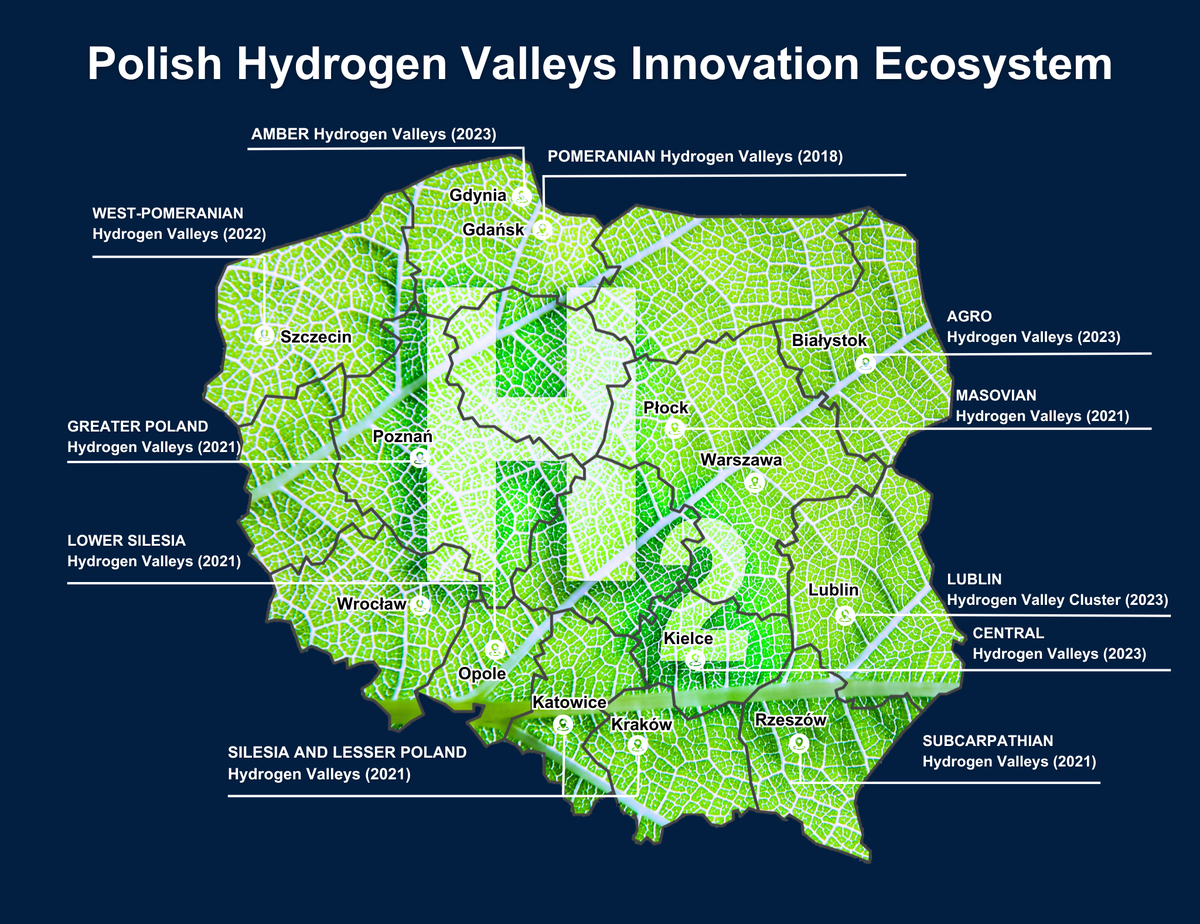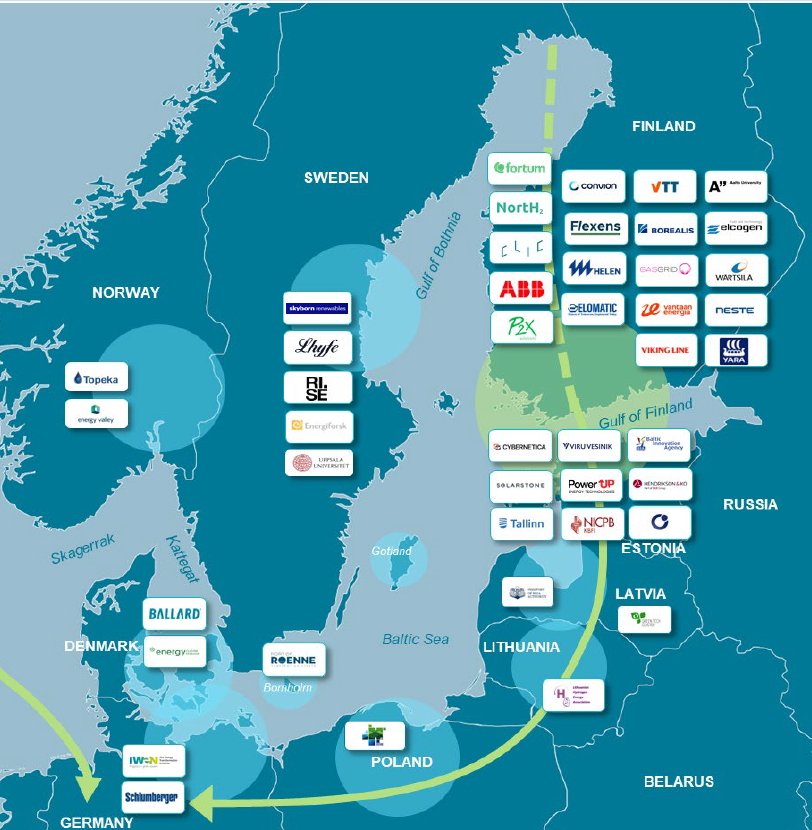What are hydrogen valleys?
Hydrogen valleys are political-social-economic ventures aimed at developing regional hydrogen markets with the full value chain of hydrogen technologies: production, transmission and storage, as well as application of hydrogen technology in many sectors of the economy. Demonstration projects of Polish hydrogen technologies will be developed in the hydrogen valleys, which, together with the potential of Polish companies, are expected to create a new economic sector based on green technologies. Funding for the hydrogen valleys will consist of EU, national and regional funds, which are intended to mobilise the private resources of Polish entrepreneurs. Hydrogen valleys will play an important role in mobilising private funds for green investments in line with the EU Taxonomy and European Green Deal regime.
According to the Clean Hydrogen Partnership, a public-private partnership that is the operator of €2 billion of EU funding for the development of the hydrogen economy, 5 key conditions must be met to talk about a hydrogen valley:
- Scale of the project - demonstration projects are not enough, the valley must include at least two large, multi-million (EUR) investments. Typically, a valley consists of a number of sub-projects that form a larger project portfolio. It is assumed that a hydrogen valley should have a minimum investment of EUR 20 million. The European average is EUR 100 million.
- Geographically defined area - hydrogen ecosystems must cover a given area / region. This could be a local hydrogen hub and its hinterland, but also a region within a country or a cross-border region - e.g. a transport corridor along a major waterway.
- Covering the hydrogen value chain - from the production of hydrogen using energy from renewable sources through the storage and distribution all the way to off-take processes.
- Use of hydrogen in several economic sectors - application of regionally produced hydrogen in projects in transport, industry and energy. One source - many applications - in different sectors. It is assumed that hydrogen should be applied in at least two economic sectors - e.g. hydrogen buses and use for green ammonia production.
Hydrogen valley in the logic of a feasibility study - the completion of a feasibility study ensures that the project has a realistic chance of being launched and obtaining EU, national and regional funding.

Hydrogen valleys in Poland
- Central Hydrogen Valley Named after the Laszczynski Brothers
Form of Activity: Association
Registered Office: Kielce
Area of Activity: Świętokrzyskie voivodeship, Łódzkie voivodeship, northern part of Podkarpackie voivodeship (Tarnobrzeg, Stalowa Wola), and southern part of Mazowieckie voivodeship (Radom, Kozienice).
Stakeholders: Świętokrzyska Grupa Industria S.A., ENEA Połaniec, ML System S.A., Łódź SEZ, Energia Europark Mielec, Rolls Royce SMR, Świętokrzyska University of Technology, Energy Institute, regional local governments, ARP S.A., Gaz System, Central Office of Measures.
Hydrogen Production: Up to 250 MW of electrolyzer capacity.
Specializations: Production of clean hydrogen, decarbonization of logistics, energy, public transport, rail transport, and hydrogen production from nuclear energy.
- Lower Silesia Hydrogen Valley
Form of Activity: Association
Registered Office: Wrocław
Area of Activity: Lower Silesian voivodeship, Opolskie voivodeship, southern parts of both Lubuskie and Wielkopolskie voivodeships, and locales such as Walbrzych, Zgorzelec, Kędzierzyn Koźle, Glogów, and the Wroclaw agglomeration.
Stakeholders: KGHM Polska Miedź, Grupa Azoty Kędzierzyn-Koźle, ARP S.A., Toyota Motor Manufacturing Poland, Total Energies, Linde Gas Poland, Wroclaw University of Technology, Wroclaw University, Promet-Plast, Polish Gas Company, Gaz-System, Z-Cluster, Lower Silesia Marshal's Office, Walbrzych SEZ, Legnica SEZ, Euro-Park Kobierzyce.
Hydrogen Production: 1700 tH2 per year
Specializations: Topics include hydrogen storage, trigeneration, chemical and metallurgical industries, green copper, hydrogen in gas networks, hydrogen in various forms of transport (like public, logistics, river with hydrogen barges), Oder Waterway, agro-voltaics, hydrogen agricultural machinery, and fostering a hydrogen tech innovation ecosystem across the Polish-Czech-German borderland.
- Masovian Hydrogen Valley
Form of Activity: Cluster
Headquarters: Płock
Area of Operation: Northern Mazovian Voivodeship, Kujawsko-Pomorskie Voivodeship, and locales like Płock, Włocławek, and Ostrołęka.
Stakeholders: Orlen Group, ARP S.A., BGK, Toyota Motor Europe, Energy Institute, National Energy Conservation Agency, Warsaw University of Technology, Warsaw University, Polish Chamber of Chemical Industry, Siemens Energy, AGH University of Science and Technology, Gaz System, Polish Gas Company.
Specializations: Topics include synthetic fuel production, petrochemical industry involvement, CO2 capture, chemical industry engagement, river transportation, public transportation with hydrogen, hydrogen bus manufacturing, hydrogen locomotive usage in the industry, and hydrogen trailers.
- West Pomeranian Hydrogen Valley
Form of Activity: Association (currently under formation)
Registered Office: Szczecin
Area of Activity: Zachodniopomorskie province, including Szczecin, Police, and Wałcz
Stakeholders: West Pomeranian University of Technology, Maritime University of Technology, Koszalin University of Technology, Port of Police, Port of Szczecin-Świnoujście, Grupa Azoty Police, Enea, ARP S.A.
Hydrogen Production: Not specified
Specializations: Green ammonia production, construction and utilization of infrastructure for ammonia import via an ammonia terminal, involvement in the chemical industry, and maritime transport.
- Greater Poland Hydrogen Valley
Form of Activity: Advisory board to the Marshal of the province
Headquarters: Poznań
Area of Activity: Wielkopolskie voivodeship, including Śrem, Piła, Konin, and Poznań
Stakeholders: Wielkopolska Marshal's Office, ZE PAK, Solaris, UAM, Poznan University of Technology, City of Śrem, City of Piła, Poznan Airport - Ławica
Hydrogen Production: 10 MW of electrolyzer capacity
Specializations: Hydrogen applications in housing and air transport, public transportation, power generation, pure hydrogen production, and bus manufacturing.
- Silesia and Lesser Poland Hydrogen Valley
Form of Activity: Association
Registered Office: Katowice
Area of Activity: Silesian and Małopolska Voivodeships, including the Upper Silesian and Zagłębie Metropolis and Cracow
Stakeholders: Orlen Południe, Polenergia, Columbus, Silesian University of Technology, Institute of Fuels, Technology and Energy, AGH University of Science and Technology, KOMAG, Azoty Tarnów Group, JSW Nowe Projekty, Katowicka SSE, Arcelor Mittal, ARP o/Katowice, Silesian Marshal's Office, Małopolska Marshal's Office.
Hydrogen Production: 350 tH2 per year (low-emission hydrogen)
Specialties: Green glycol, green steel, low-carbon hydrogen production, and decarbonization of public transportation.
- Subcarpathian Hydrogen Valley
Form of Activity: Association
Registered Office: Rzeszów
Area of Activity: Subcarpathian voivodeship, including Sanok, Rzeszów, and Mielec Aviation Valley
Stakeholders: Rzeszow University of Technology, Polenergia Nowa Sarzyna, Autosan, ML System, Podkarpackie Marshal's Office, ARP o/Tarnobrzeg, Institute of Energy
Hydrogen Production: 5 MW from electrolyzers
Specializations: Zero-emission hydrogen production, application of hydrogen in heating and power, hydrogen-powered buses, and its use in public transportation
- Pomeranian Hydrogen Valley
Form of Activity: Chamber of Commerce/Cluster
Registered Office: Gdańsk
Area of Operation: Pomorskie voivodeship, including Gdynia, Gdansk, and Wejherowo
Stakeholders: Pomeranian Marshal's Office, Sescom, Gdansk University of Technology, Nexus, Hydrogen Technology Cluster, ASE Group
Hydrogen Production: Not available
Specializations: Use of hydrogen in public transportation, hydrogen storage solutions, production of clean hydrogen sourced from offshore energy, and electrolyzer manufacturing
- Lublin Hydrogen Valley Cluster
Form of Activity: Cluster
Headquarters: Puławy
Area of Activity: Lubelskie voivodeship, Lublin, Puławy.
Stakeholders: Azoty Pulawy Group, Lubelski Węgiel Bogdanka, Lublin Science and Technology Park, Lublin Marshal's Office, Łukasiewicz Research Network.
Hydrogen Production: N/A
Specialties: Production of green hydrogen for the chemical industry, production of hydrogen buses, and hydrogen usage in public transportation.


Example of hydrogen valley activities in Poland - Baltic Hydrogen Valley
The Lower Silesian Hydrogen Valley Association has joined an international consortium of 37 Baltic Sea stakeholders.
All countries in the region are involved in the project: Finland, Estonia (leader), Denmark, Sweden, Germany, Norway, Lithuania, Latvia and Poland (except Russia).
The purpose of the project is to create a regional hydrogen market in the full value chain of hydrogen technologies in the Baltic Sea area.
As part of the project submitted to the Clean Hydrogen Partnership in the Large Hydrogen Valley competition, EUR 25 million is earmarked for the development of the Baltic project.
The consortium consists of technology companies, energy companies and regional energy transition leaders.

mail: h2v@arp.pl











